10. THE CYRUS CYLINDER
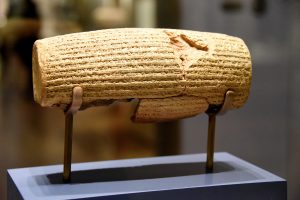
Date of Artifact: 6th century BCE
Location of Creation: Persia
Date of Finding: 1879
Location Found: Iraq
Biblical passages related: Isaiah 44:28 | Ezra 1:1-4 | 2 Chronicles | 36:22-23 | Ezra 6:4-5 | Daniel 10:1 | Daniel 6:28
The Cyrus Cylinder dates from the 6th century BCE and was discovered in the ruins of Babylon, modern day Iraq, in 1879. It is named after the figure that stars in it’s text, King Cyrus of Persia.
Cyrus was also referred to as Cyrus the Great. Cyrus was born between 590 & 580 BCE, in the Media or Persis region. According to ancient Akkadian texts, and according to the cylinder, Cyrus was tied to a lineage of royal leaders. His kingship is mentioned multiple times on the stone cylinder.
I am Cyrus, king of the universe, the great king, the powerful king, king of Babylon, king of Sumer and Akkad, king of the four quarters of the world, son of Cambyses, the great king,, king of the city of Anshan, grandson of Cyrus, the great king, ki[ng of the ci]ty of Anshan, descendant of Teispes, the great king, king of Anshan, the perpetual seed of kingship, whose reign Bel and Nabu love, and with whose kingship, to their joy, they concern themselves
[The] son of Cambyses, great king, king of Anshan, grandson of Cyrus, great king, king of Anshan, descendant of Teispes, great king, king of Anshan, of a family [which] always [exercised] kingship.
His lineage should not be overlooked, as it was what propelled him to power. His parents were both prince and princess. His mother was the daughter of the king of Medes and his father was the son of the king of Persis, which was a vassal of Medes. A vassal nation or vassal group is a group of people that are under the leadership of another nation group; often the result of a failed military battle.
According to the Greek telling of Cyrus’ rise to power, Cyrus overthrew his father his father as the when he was the king of Medes. After the usurping of the throne in 550 BCE, Cyrus began consolidating the rest of the populations in Iran underneath the Medes. Cyrus eventually conquered all the peoples in the Persian area and then turned westward to conquer all of Babylon. He succeeded in 539 BCE.
At the time, the Babylonian empire was the largest and most powerful in all the lands. How did Cyrus manage to bring down such a nation? Cyrus was known for treating his conquered people well. He let them worship their own Gods and stay in their own villages. He did not murder the captured inhabitants either. As he conquered groups of people they actually submitted willingly to the Persian empire, knowing that being a vassal of Persia was a safe place to be. In fact, this is why Cyrus is known to the Jews as liberator.
As the Babylonians conquered the Mediterranean lands they raped, pillaged, and murdered anyone on their way. The Jews were taken into exile and many murdered. They were marched in a long line with fish hooks in their noses. The biblical imagery is haunting.
So the LORD brought against them the army commanders of the king of Assyria, who took Manasseh prisoner, put a hook in his nose, bound him with bronze shackles and took him to Babylon. (2 Chronicles 13:22)
However, Cyrus was different. When he defeated the Babylonians he let the captives of Babylon free. The prophet Isaiah foretold of Cyrus saying,
Cyrus, ‘He is my shepherd
and will accomplish all that I please;
he will say of Jerusalem, “Let it be rebuilt,”
and of the temple, “Let its foundations be laid. (Isaiah 44:28)
9. INSCRIPTIONS FROM SARGON PALACE
 Date of Artifact: 7th century BCE
Date of Artifact: 7th century BCE
Location of Creation: Present day Khorsabad, Northern Iraq
Date of Finding: Early 1800’s
Location Found: Iraq
Biblical passages related: 2 Kings 17| Isaiah 20 |
The Palace of Sargon is a bit of a misnomer because there was more than one Sargon. Typically when the inscriptions on Sargon’s palace is mentioned, it’s referring to Sargon II. The first Sargon, Sargon the Great, lived some 1700 years earlier. Sargon II lived from 765-705 BCE.
Sargon is known for many things but most notably in modern times for his vast military campaigns. Though, not as brutal as the Babylonians, the Akkadian leader conquered northern Israel and most all of the Hittite region. Under Sargon’s reign the Akkadian empire reached it’s peak in world dominance and wealth. The territory spanned all of Mesopotamia, modern day eastern Turkey, modern day and western Iran.
The Bible records the Akkadian rise to power and then the eventual conquering of the northern Tribes. The inscriptions on Sargon’s palace tell about the conquest in great detail. The palace is a tribute to the greatness of Sargon.
“In my first year I besieged and conquered Samaria . . . I lead away 27,290 prisoners . . . I ordered tribute to be made to me . . . Hanno king of Gaza and also Sib’e the tartan of Egypt set out to engage me in battle. I defeated them . . . I received tribute from (pharaoh) Piye of Egypt . . . Iamani of Ashdod fled to the frontier of Egypt which belongs to Ethiopia . . . Frightened of my power, the king of Ethiopia put chains on Iamani’s hands and feet and sent him to me. I conquered the towns of Samaria and all Israel.” (ANET 284-285)
The biblical account states that the siege took years and it appears that the original siege started under Sargon’s father, Shalmanese V. However, it was Sargon who finished the conquest and resettled the land.
Shalmaneser king of Assyria came up to attack Hoshea, who had been Shalmaneser’s vassal and had paid him tribute. 4 But the king of Assyria discovered that Hoshea was a traitor, for he had sent envoys to So king of Egypt, and he no longer paid tribute to the king of Assyria, as he had done year by year. Therefore Shalmaneser seized him and put him in prison. 5 The king of Assyria invaded the entire land, marched against Samaria and laid siege to it for three years. 6 In the ninth year of Hoshea, the king of Assyria captured Samaria and deported the Israelites to Assyria. He settled them in Halah, in Gozanon the Habor River and in the towns of the Medes. (2 Kings 17:3-6)
The king of Assyria brought people from Babylon, Kuthah, Avva, Hamath and Sepharvaim and settled them in the towns of Samaria to replace the Israelites. They took over Samaria and lived in its towns.25 When they first lived there, they did not worship the Lord; so he sent lions among them and they killed some of the people. 26 It was reported to the king of Assyria: “The people you deported and resettled in the towns of Samaria do not know what the god of that country requires. He has sent lions among them, which are killing them off, because the people do not know what he requires.”
27 Then the king of Assyria gave this order: “Have one of the priests you took captive from Samaria go back to live there and teach the people what the god of the land requires.” 28 So one of the priests who had been exiled from Samaria came to live in Bethel and taught them how to worship the Lord. (2 Kings 17:24-28)
The prophet Isaiah recorded an oracle from the Lord that give us some insight to the stratification of Israel society. Many of the Israelites actually pledged loyalty to Egypt and even moved south towards Egypt, thinking Egypt could protect them from the invasion of the Akkadian army. However, God reprimanded them for running to Egypt and not the Lord. In the end, the Akkadians ended up taking over much of Egypt as well. The takeover of Egpyt was recorded also in the Sargon inscriptions.
In the year that the supreme commander, sent by Sargon king of Assyria, came to Ashdod and attacked and captured it— 2 at that time the Lord spoke through Isaiah son of Amoz. He said to him, “Take off the sackcloth from your body and the sandals from your feet.” And he did so, going around stripped and barefoot.
3 Then the Lord said, “Just as my servant Isaiah has gone stripped and barefoot for three years, as a sign and portent against Egypt and Cush, 4 so the king of Assyria will lead away stripped and barefoot the Egyptian captives and Cushite exiles, young and old, with buttocks bared—to Egypt’s shame. 5 Those who trusted in Cush and boasted in Egypt will be dismayed and put to shame. 6 In that day the people who live on this coast will say, ‘See what has happened to those we relied on, those we fled to for help and deliverance from the king of Assyria! How then can we escape?’”
8. THE KURKH MONOLITH(S)

 Date of Artifact: 8th century BCE
Date of Artifact: 8th century BCE
Location of Creation: Western Bablyon/Akkadia
Date of Finding: 1861
Location Found: Kurkh, Turkey
Biblical passages related: 1 Kings 20:31-34 | 1 Kings 22 | 2 Kings 1:1; 3:4, 5
The Kurkh Monoliths are two Assyrian stela that contain a description of the reigns of Ashurnasirpal II and his son Shalmaneser III. The stela dedicated to Ashurnasirpal speaks of a time period just before Shalmaneser III. It is less discussed than the other stele from Kurkh because it does not correlate much history related to biblical matters. It weighs in at a whopping 3 tons and stands 3 meters (about 9ft) tall. It is sometimes called the “Banquet Stela” because it was made to commemorate Ashurnasirpal’s newly rebuilt city and palace. This stele was placed at the entrance of the new palace. For more on this stone refer to our article “Biblical Archaeology: The Banquet Stela of Ashurnasirpal II“. The other stela we will discuss below.
The stone monument dedicated to Shalmaneser III is remarkable for a few reasons. It is one of the oldest inscriptions that mentions Israel and king Ahab. The stele records some of the booty collected on a military campaign, as the Assyrian army pushed further into the Mediterranean region. The booty included “2,000 chariots, 10,000 soldiers of Ahab, the Israelite“. Ahab reigned from 871–852 BCE. Little did Ahab know that soon the Assyrian army would campaign through the northern regions of Israel and exile the 10 northern tribes.
His officials said to him, “Look, we have heard that the kings of Israel are merciful. Let us go to the king of Israel with sackcloth around our waists and ropes around our heads. Perhaps he will spare your life.” 32 Wearing sackcloth around their waists and ropes around their heads, they went to the king of Israel and said, “Your servant Ben-Hadad says: ‘Please let me live.’” The king answered, “Is he still alive? He is my brother.”
33 The men took this as a good sign and were quick to pick up his word. “Yes, your brother Ben-Hadad!” they said. “Go and get him,” the king said. When Ben-Hadad came out, Ahab had him come up into his chariot. 34 “I will return the cities my father took from your father,” Ben-Hadadoffered. “You may set up your own market areas in Damascus, as my father did in Samaria.”
Ahab said, “On the basis of a treaty I will set you free.” So he made a treaty with him, and let him go.
(1 Kings 20:31-34)
7. THE MESHA STELE (MOABITE STONE)
 Date of Artifact: 8th century BCE
Date of Artifact: 8th century BCE
Location of Creation: Moab
Date of Finding: 1868
Location Found: Dhiban, Jordan
Biblical passages related: 1 Kings 16:23 | 1 Kings 16:29 | 2 Kings 1 | 2 Kings 3 |
The Mesha Stele is often called the Moabite stone because it was clearly a Moabite creation and it recounts the history of Moab’s subjugation to Israel. It is prized as being one of the oldest artifacts to mention the “house of David”, referring to King David, who united all of Israel under his military leadership. The stone also mentions YHWH, King Omri, and the Moabite revolt against Israel. Since it’s a record of history it covers a number of biblical events and names.
One interesting thing about the stone is that it creates a mythological story about why Moab was defeated in battle by Israel. The story is designed very similar to the battle stories of Israel in the OT. According to the author of the Moabite stone, the Moabites did wrong in the sight of their god (Chemosh) and he sent them into a time of punishment.
Omri was the king of Israel,
and he oppressed Moab for many days,
for Kemosh was angry with his land.
(Mesha Stele, lines 5-7a)
The stone goes on to tell of the Moabite revolt against Israel which is recorded in the Bible as well.
Now Mesha king of Moab raised sheep, and he had to pay the king of Israel a tribute of a hundred thousand lambs and the wool of a hundred thousand rams. 5 But after Ahab died, the king of Moab rebelled against the king of Israel. 6 So at that time King Joram set out from Samaria and mobilized all Israel. 7 He also sent this message to Jehoshaphat king of Judah: “The king of Moab has rebelled against me. Will you go with me to fight against Moab?” (2 Kings 3:4-7 NIV)
For a full decoding of the stone in the original language, modern Hebrew, and English, download this short PDF providing a detailed breakdown of the stela. [The Moabite Stone A Facsimile of the Original Inscription]
6. THE BLACK OBELISK
 Date of Artifact: 825 BCE
Date of Artifact: 825 BCE
Location of Creation: Nimrud (Iraq)
Date of Finding: 1846
Location Found: Dhiban, Jordan
Biblical passages related: 1 Kings 20:31-34 | 1 Kings 22 | 2 Kings 1:1; 3:4, 5
Similar to the later Kurkh Monolith, the war annals of Shalmaneser III were recorded all over his palace and various monuments. Like some of his predecessors, Shalmaneser wanted make sure the world knew of his greatness for generations to come. Perhaps the most important of Shalmaneser’s constructions was a black, 4 sided, monument that recorded his military exploits as well as pictures of certain events.
The Black Obelisk is important to the field of Old Testament archaeology because it verifies events in the Bible that are not well covered outside of the Bible. It is also the most complete Assyrian obelisk yet to be discovered.
The Obelisk also contains images of Israel paying tribute to the Assyrian empire as well as other conquered nations. This coincides with the biblical accounts of Shalmaneser in the book of Kings.
Shalmaneser king of Assyria came up to attack Hoshea, who had been Shalmaneser’s vassal and had paid him tribute. 4 But the king of Assyria discovered that Hoshea was a traitor, for he had sent envoys to Soa king of Egypt, and he no longer paid tribute to the king of Assyria, as he had done year by year. Therefore Shalmaneser seized him and put him in prison. 5 The king of Assyria invaded the entire land, marched against Samaria and laid siege to it for three years. 6 In the ninth year of Hoshea, the king of Assyria captured Samaria and deported the Israelites to Assyria. He settled them in Halah, in Gozan on the Habor River and in the towns of the Medes. (2 Kings 17:3-6)
5. SENNACHERIB’S PRISM
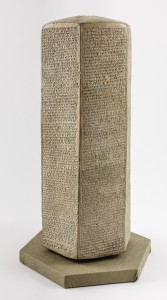
The prism that is know as Sennacherib’s Prism, or Taylor’s Prism, contains the war annals of Assyrian Sennacherib’s. It’s significance to Christianity and Judaism is that it records the siege of Jerusalem and even includes King Hezekiah’s name in the war annals.Date of Artifact: 690 BCE
Location of Creation: Nineveh
Date of Finding: 1830
Location Found: Nineveh
Biblical passages related: 2 Kings 19:9-10 | Isaiah 37:1-38 | 2 Kings 18:1-19:37 | 2 Chronicles 32:33
Sennacherib was one of multiple Assyrian leaders that attempted to take Judah in battle. However, siege against the cities of Judah would take decades to complete and would ultimately fall to the next would power, Babylon, rather than to Assyria.
The siege(s) of Jerusalem was one of the most catastrophic events in Jewish history. It should be of no surprise that it was recorded in the war annals of the opposing forces. It also demonstrates that Jerusalem was a city of great size and importance by the 7th century BCE, despite the claims that Jerusalem’s size and importance was over-stated in the Bible. While it may be hard to know exactly how large of a city it was, one thing is for sure, Jerusalem was big enough to warrant it’s place in the list of accomplishments by Sennacherib’s annals, though it appears that it took multiple attempts. The attempt recorded in the Prism is not of the final battle which lead to the defeat of Jerusalem. That is recorded in later annals of Sennacherib.
Now Sennacherib received a report that Tirhakah, the king of Cush,a was marching out to fight against him. So he again sent messengers to Hezekiah with this word: 10 “Say to Hezekiah king of Judah: Do not let the god you depend on deceive you when he says, ‘Jerusalem will not be given into the hands of the king of Assyria.’ (2 Kings 19:9-10)
While the Jewish account was a bit more favorable to the Jews, Sennacherib’s account was much different. In the Assyrian account, Jerusalem is not really besieged. In fact, Sennacherib seems to show some type of vassal alliance with Hezekiah.
I besieged, I conquered, I carried off their spoil. The officials, nobles, and people of Ekron, who had thrown Padi, their king, bound by lord of oath and curse of Assyria, into fetters of iron and had given him over to Hezekiah, the Jew, – he kept him in confinement like an enemy. (lines 72-77 of Sennacherib’s Prism)
For a full translation of nearly all of the known annals of Sennacherib, use this link to download the PDF form. Annals of Sennacherib
3. LACHISH GATE SHRINE
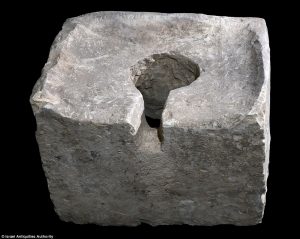 Date of Artifact: 1200?-690 BCE
Date of Artifact: 1200?-690 BCE
Location of Creation: Ancient city of Lachish
Date of Finding: 2016
Location Found: Ancient city of Lachish
Biblical passages related: 2 Kings 14:19 | 2 Kings 18:4 | Joshua 10 | Joshua 12:11 | Joshua 15:39 | Isaiah 36:2 | Jeremiah 34:7 | Micah 1:13
The ancient city of Lachish was just a bit south west of Jerusalem and was characterized as place where pagan worship took place. In fact, when King Hezekiah took the throne in Judah, he tore down the shrine located at the gate of Lachish. In 2016, archaeologists not only discovered the gate at Lachish but also a shrine, most likely similar to the one torn down by Hezekiah.
He removed the high places, smashed the sacred stones and cut down the Asherah poles…” (II Kings 18:4)
The fact that this shrine still exists is most likely because shortly after it was torn down, Judah became under siege by the Assyrians and eventually the Babylonians. The final siege against Lachish, by the Babylonians, was recorded by Jeremiah as well as the historical writers. It is believed to have been destroyed by Sennacherib, in 701 BCE. Reliefs of this destruction and subjugation exist still today.
while the army of the king of Babylon was fighting against Jerusalem and the other cities of Judah that were still holding out—Lachish and Azekah. These were the only fortified cities left in Judah. (Jeremiah 34:7)
However, Lachish is a very ancient city. Joshua lead an attack against Lachish, some 600-800 years before Hezekiah.
Then Joshua and all Israel with him moved on from Libnah to Lachish; he took up positions against it and attacked it. (Joshua 10:31)
The site, which is still being uncovered, has produced clay fragments, seals, personal items, weapons, and even public toilets.
2. THE NUZI TABLETS
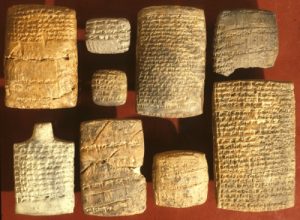 Date of Artifact: 1450-1350 BCE
Date of Artifact: 1450-1350 BCE
Location of Creation: northern Iraq
Date of Finding: 1925-1933
Location Found: northern Iraq
Biblical passages related: Genesis 15:2 | Genesis 38 | Deuteronomy 25:5
The Nuzi tablets are a collection of 6,500 cuneiform texts and fragments that have been discovered in northeastern Iraq. They deal with the social, economic, religious and legal institutions of the Hurrian people. The importance of these tablets is summed up best by biblicalarchaeology.org.
The tablets tell of practices similar to those in Genesis such as adoption for childless couples (Genesis 15:2) children by proxy (Genesis 16; 21:1), inheritance rights (Genesis 25:29), marriage arrangements (Genesis 28) and levirate marriage (Genesis 38 & Deuteronomy 25:5). They also demonstrate the significance of the deathbed blessing (Genesis 27; 48) and household gods (Genesis 31:14 30). Some Nuzi tablets, called “tablets of sistership agreements in which a man adopted a woman as a sister. In the society of the Hurrians, a wife enjoyed both greater protection and a superior position when she also had the legal status of a sister. In such a case, two separate documents were drawn up, one for marriage and the other for sistership. This may explain why both Abraham (Genesis 12:10 20:1) and Isaac (Genesis 26:7) said their wives were their sisters. It is possible that they had previously adopted them to give them higher status, in accordance with the custom of the day. (Source)
The culture of the OT patriarchs is believed by many to be strange yet history teaches us otherwise. The Nuzi tablets demonstrate that the biblical customs of the OT were normal and common.
1. THE MERNEPTAH STELE
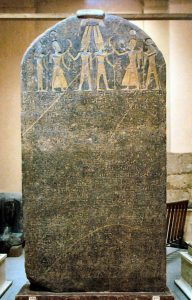 Date of Artifact: 1213 to 1203 BCE
Date of Artifact: 1213 to 1203 BCE
Location of Creation: Egypt
Date of Finding: 1896
Location Found: Thebes
Biblical passages related: Genesis | Exodus
Egyptian king, Merneptah, reigned from 1213 to 1203 BCE. The stele associated with King Merneptah records military records and victory booty. It’s often referred to as the “Israel Stele” because it’s the oldest known mention of the nation of Israel. The time frame of Merneptah would have been just 200 years after the exodus even or immediately after it, depending on the exodus dating method. Thus, it’s mention of Israel is remarkable.
The Canaan has been plundered into every sort of woe:
Ashkelon has been overcome;
Gezer has been captured;
Yano’am is made non-existent.
Israel is laid waste and his seed is not;
Hurru is become a widow because of Egypt. (Merneptah Stele, lines 27-28)
Note that the nation listed right after Israel was Hurru of the Hurrians, which were the peoples that gave us the Nuzi tablets. The Hurrians were Israel’s neighbors directly to the North, just east of the Hittites. The fact that Egypt’s conquest ranged from southern cities like Gezer all the way to Hurru is a good indicator that “Israel” is the correct translation of the text in line 27, though some have disputed it.
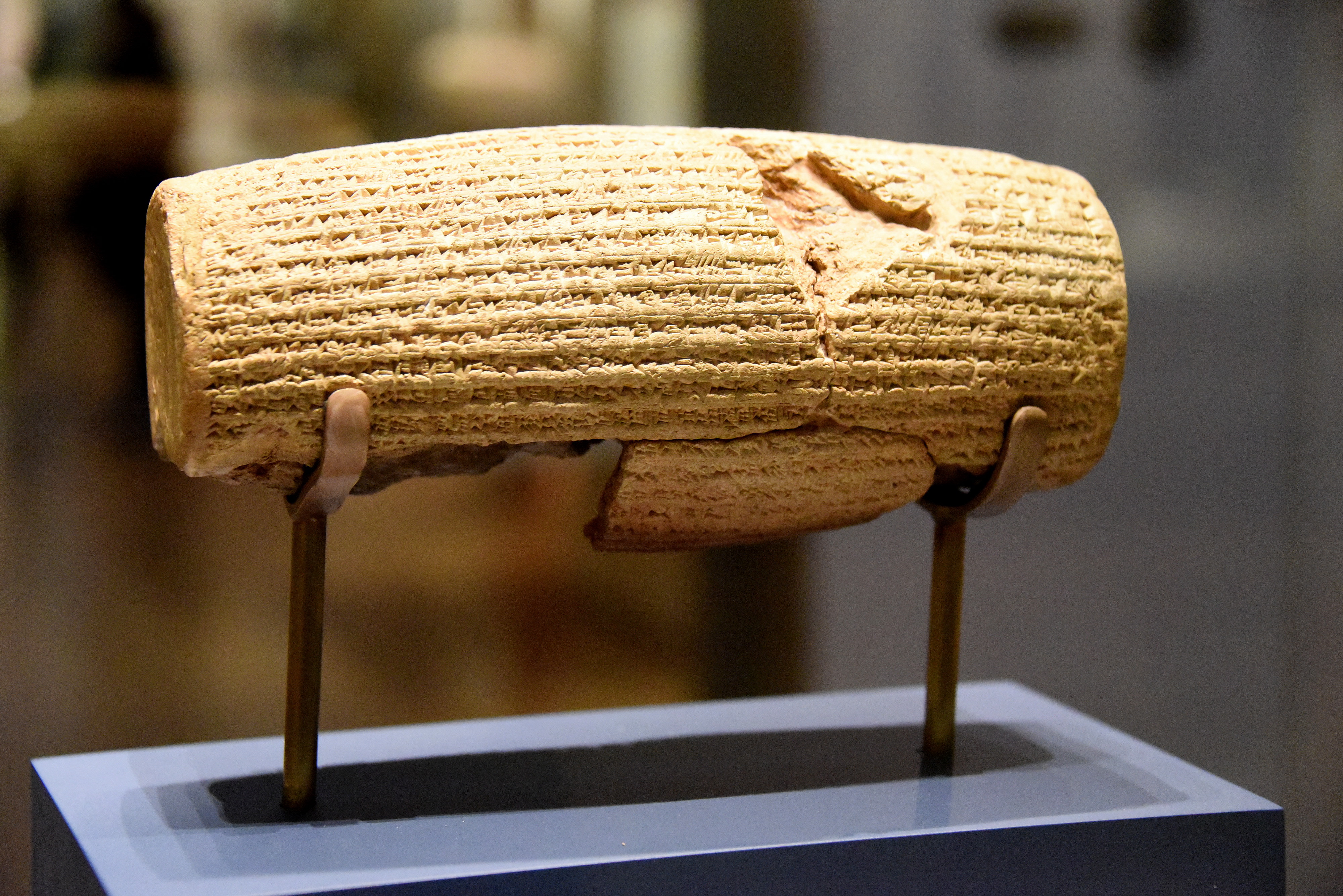




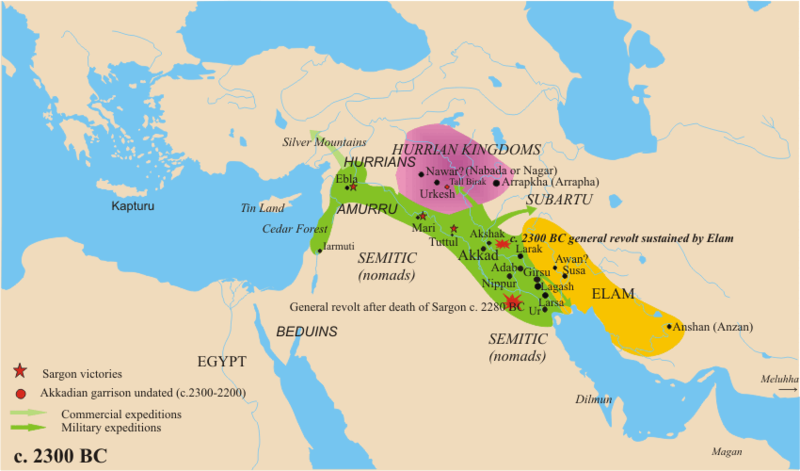
I get that. I find it interesting that throughout history across the world, there are a variety of the flood stories. Epic of Gilgamesh speaks of it, the Anishinaabe tribe of Canada have it as a large canoe vs boat, the Viking age peoples (pre-christianity) had a flood story… I find it fascinating. It does tell me one of two things in my opinion. The flood narrative in the bible was not a world wide event wiping out all of humanity, but more just the region. Or the story made its way across the earth and just changed to fit the narrative/design of the people of that region. It really has made me rethink a lot about Christianity and the how we presently interpret the Bible. How do we adequately discern what was “law”(of Paul’s Epistles) and what was more current law/tradition of the times? I personally start looking from the emergence of Jesus’ commandment (Mark 12:30-31) and extrapolate my thoughts, behaviours, choices in life from that, and only just that. It’s not a position that’s well received in local churches.
I agree. The many flood narratives are best explained by accepting that some major flood occurred. While it’s all but impossible to very the Noah story, we can still assume with some confidence that a flood absolutely happened and probably more than a few people tried to withstand the flood with a boat.
I would like to see some information about the Mesopotamian and Babylonian versions of the creation, and the similarities to Genesis, the flood and Noah to name a few. The Enûma Eliš is what I am comparing Genesis to. I struggle because what is actually correct, Enûma Eliš recount or does Genesis tell the same/similar story but correctly?
Robert, I think most creation myths are designed to be less historical as modern thinkers would like. Even parts of Genesis are clearly mythical and theological in nature. In the first 1/4th of Genesis all of the people introduced have names in Hebrew that correspond to their role in the story. This is characteristic of a made up story or a story where the original names were not known. But there is a clear cutoff point where the names of people go back to a normal convention, right after the patriarchs.
I would not worry about which story is “correct” and instead worry about the message trying to be communicated by the story. Remember that part of Genesis were oral only for hundreds of years. Oral traditions have a tendency to get morphed through time, but the core message is always the same.
After the patriarchs though, Genesis does start to turn more historical. So much so that it can be corroborated by other texts and archaeological finds.